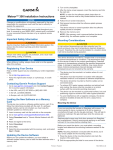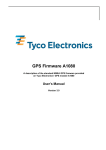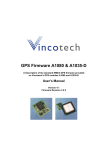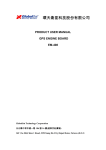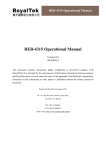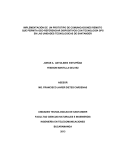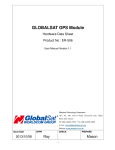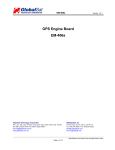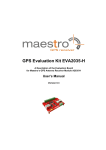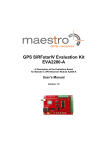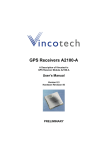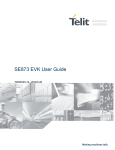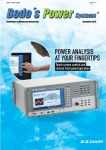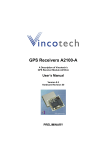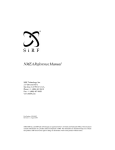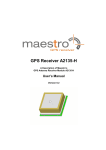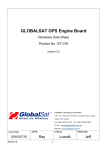Download User`s Manual
Transcript
GPS Firmware for GSD4e-based Products A Description of the standard NMEA GPS firmware provided on Vincotech’s GPS modules based on SiRFstarIV – GSD4e A2100 User’s Manual Version 0.1 Firmware Revision 3.6.0 PRELIMINARY PRELIMINARY Revision History Rev. Date 0.1 04-16-10 Description Initial draft mm-dd-yy V0.1 - Apr-10 User’s Manual Page 2 of 28 PRELIMINARY Disclaimer THIS DOCUMENT CONTAINS PROPRIETARY INFORMATION OF VINCOTECH GMBH. IT MAY NOT BE COPIED OR TRANSMITTED BY ANY MEANS, PASSED TO OTHERS, OR STORED IN ANY RETRIEVAL SYSTEM OR MEDIA, WITHOUT PRIOR CONSENT OF VINCOTECH OR ITS AUTHORIZED AGENTS. THE INFORMATION IN THIS DOCUMENT IS, TO THE BEST OF OUR KNOWLEDGE, ENTIRELY CORRECT. HOWEVER, VINCOTECH CAN NEITHER ACCEPT LIABILITY FOR ANY INACCURACIES, OR THE CONSEQUENCES THEREOF, NOR FOR ANY LIABILITY ARISING FROM THE USE OR APPLICATION OF ANY CIRCUIT, PRODUCT, OR EXAMPLE SHOWN IN THE DOCUMENT. THE PRODUCT (HARD- AND SOFTWARE) DESCRIBED IN THIS DOCUMENTATION IS NOT AUTHORIZED FOR USE IN LIFE SUPPORT DEVICES OR SYSTEMS WITHOUT THE EXPRESS WRITTEN APPROVAL OF VINCOTECH. THIS DOCUMENT MAY PROVIDE LINKS TO OTHER WORLD WIDE WEB SITES OR RESOURCES. BECAUSE VINCOTECH HAS NO CONTROL OVER SUCH SITES AND RESOURCES, VINCOTECH SHALL NOT BE RESPONSIBLE FOR THE AVAILABILITY OF SUCH EXTERNAL SITES OR RESOURCES, AND DOES NOT ENDORSE AND IS NOT RESPONSIBLE OR LIABLE FOR ANY CONTENT, ADVERTISING, PRODUCTS, OR OTHER MATERIALS ON OR AVAILABLE FROM SUCH SITES OR RESOURCES. VINCOTECH SHALL NOT BE RESPONSIBLE OR LIABLE, DIRECTLY OR INDIRECTLY, FOR ANY DAMAGE OR LOSS CAUSED OR ALLEGED TO BE CAUSED BY OR IN CONNECTION WITH USE OF OR RELIANCE ON ANY SUCH CONTENT, GOODS OR SERVICES AVAILABLE ON OR THROUGH ANY SUCH SITE OR RESOURCE. VINCOTECH RESERVES THE RIGHT TO CHANGE, MODIFY, OR IMPROVE THIS DOCUMENT OR THE PRODUCT DESCRIBED HEREIN, AS SEEN FIT BY VINCOTECH WITHOUT FURTHER NOTICE. V0.1 - Apr-10 User’s Manual Page 3 of 28 PRELIMINARY Table of Contents 1 Introduction ........................................................................................................ 5 1.1 Serial Port Configuration ................................................................................... 5 1.2 Cold Start Behaviour ......................................................................................... 6 1.2.1 Additional Output Messages....................................................................................... 6 1.2.2 InstantFix – Extended Ephemeris Support ................................................................. 6 2 Standard NMEA Sentences ............................................................................... 7 2.1 Introduction ....................................................................................................... 7 2.2 Supported NMEA Sentences ............................................................................ 7 2.2.1 GGA - Global Positioning System Fix Data ................................................................ 8 2.2.2 VTG – Course Over Ground and Ground Speed ....................................................... 9 2.2.3 RMC - Recommended Minimum Specific GPS Data ............................................... 10 2.2.4 GSA - GPS DOP and Active Satellites ..................................................................... 11 2.2.5 GSV – GPS Satellites in View .................................................................................. 12 2.2.6 GLL – Latitude, Longitude, UTC and status ............................................................. 13 3 Proprietary NMEA Sentences ......................................................................... 14 3.1 Transport Message ......................................................................................... 14 3.2 NMEA Input Messages ................................................................................... 15 3.3 Serial Port Set-up............................................................................................ 15 3.4 Reset Configuration (SiRF’s original: NavigationInitialization) ........................ 16 3.5 Query/Rate control .......................................................................................... 17 3.6 Development Data On/Off............................................................................... 18 3.7 Select Datum .................................................................................................. 19 3.8 Shut-Down Module.......................................................................................... 19 4 NMEA and Binary mode .................................................................................. 20 4.1 From NMEA to Binary Mode ........................................................................... 20 4.2 From Binary to NMEA Mode ........................................................................... 21 5 Important Binary Commands .......................................................................... 23 5.1 Static Mode ..................................................................................................... 23 5.2 SBAS Support ................................................................................................. 24 5.3 SiRFawareTM Mode ......................................................................................... 25 5.4 Shut-Down Module.......................................................................................... 25 6 Related Information ......................................................................................... 27 6.1 Contact............................................................................................................ 27 6.2 Related Documents......................................................................................... 27 6.3 Related Tools .................................................................................................. 27 7 List of Tables .................................................................................................... 28 V0.1 - Apr-10 User’s Manual Page 4 of 28 PRELIMINARY 1 Introduction This document contains a description of NMEA output sentences, NMEA commands, and special OSP / Binary Protocol commands which are implemented in the standard GPS firmware used in all GPS modules based on the SiRFstarIV GSD4e chip: A2100’s. For more details of the original SiRF firmware please see chapter “6.2 Related Documents”. This revision of the manual refers to firmware 4.0.1! The purpose of this paper is the explanation of the behavior of the “NMEA” interface, i.e. a description of the outputs coming from this interface, and a summary of the commands that can be issued to this interface. In addition it shows usage of SiRFawareTM and PTF mode. This will allow easy and full adjustment and control of the module. 1.1 Serial Port Configuration The firmware supports the bi-directional serial interface of Vincotech’s GPS modules. It is implemented by use of the full duplex UART (Universal Asynchronous Receiver Transmitter) interface of the GPS processor. Please note that it is necessary to configure the module with an external configuration resistor for UART mode with the standard 4.0.1 firmware. • • • For the communication with UART the use of a kind of terminal program or another appropriate method is necessary. NMEA communication is always on port 0 (pin Tx0 and Rx0) of the module or on the serial USB port of one of the evaluation boards, respectively. The default configuration of this serial port is: 4800 baud, 8 data bits, no parity, 1 stop bit, no flow control. This interface is bi-directional, i.e. on the one side the output of the GPS modules (NMEA sentences, etc.) is sent to the UART interface, on the other side the UART interface can be used to send commands to Vincotech’s GPS modules. V0.1 - Apr-10 User’s Manual Page 5 of 28 PRELIMINARY 1.2 Cold Start Behaviour After an initial power on the module will start with a sequence like this: $GPGGA,,,,0,00,,,M,0.0,M,,0000*48 $GPGSA,*6E $GPRMC,,*4B $GPGGA,,,,0,00,,,M,0.0,M,,0000*48 $GPGSA,*6E $GPRMC,,*4B … In NMEA mode the firmware will not report time, date or any signal information, until a position fix can be calculated. Therefore, also the GPGSV sentence is missing. If this information is required, it is necessary to switch to SiRF Binary mode. 1.2.1 Additional Output Messages Occasionally, the following message can be seen: • $PSRF156,23,1,0*09 This is the receiver’s message to request a download. The download can be started immediately. In addition the following message (or a similar one) can be seen: • $PSRF151,2,0,30094,0xFFFFFFFF*56 With this message the receiver is showing GPS data (time valid, week, time of week) and the Ephemeris mask. The Ephemeris mask is indicating which satellite’s Ephemeris data should still be loaded. 1.2.2 InstantFix – Extended Ephemeris Support The firmware supports both Client generated as well as Server generated Extended Ephemeris (EE) data. Client generated data are calculated automatically, as soon as broadcasted Ephemeris data are available. The validity of these data is up to three days. For details about the Server generated EE data, please refer to the application notes • • GPS AppNote EE Receiver Load (Vincotech) GPS AppNote EE Server Download (Vincotech) V0.1 - Apr-10 User’s Manual Page 6 of 28 PRELIMINARY 2 Standard NMEA Sentences 2.1 Introduction The National Marine Electronics Association created a uniform interface standard for digital data exchange between different marine electronic products back in the early nineteen-eighties. • • • • • NMEA information is transmitted from a ‘vendor’ in ‘sentences’ with a maximum length of 80 characters. The general format is: ”$<vendor><message><parameters>*<checksum><CR><LF>”. The combination of <vendor><message> is called address field. The vendor code for the Global Positioning System is “GP”. In this document NMEA sentences refer to the NMEA 0183 Standard. For details see: http://www.nmea.org/ http://www.nmea.org/pub/index.html 2.2 Supported NMEA Sentences The Vincotech’s GPS firmware currently supports 6 NMEA sentences: • • • • • • $GPGGA (default: ON) $GPVTG (default: OFF) $GPGSA (default: ON) $GPRMC (default: ON) $GPGSV (default: ON, 0.2Hz) $GPGLL (default: OFF) Note: Please consider max transfer rate (depending on baud rate setting) before activating additional NMEA sentences. The following paragraphs give an overview of NMEA messages with example strings and short explanation. V0.1 - Apr-10 User’s Manual Page 7 of 28 PRELIMINARY 2.2.1 GGA - Global Positioning System Fix Data e.g. $GPGGA,152145.000,4805.8193,N,01132.2317,E,1,04,2.5,607.5,M,47.6,M,,*67 (1) (2) (3) $GPGGA 152145.000 4805.8193 (4) N (5) 01132.2317 (6) E (7) 1 (8) (9) (10) (11) (12) (13) (14) (15) (16) 04 2.5 607.5 M 47.6 M <empty> <empty> *67 Vendor and message identifier Universal time coordinated (15h 21m 45.000s) Latitude (48deg 05.8193min) N North S South Longitude (011deg 32.2317min) E East W West Fix quality: 0 fix not valid or invalid, 1 GPS SPS mode, fix valid, 2 Differential GPS, SPS mode, fix valid Four satellites in use (min 00, max 12) Horizontal dilution of precision MSL altitude Unit of antenna altitude: meters Geoidal separation Unit of geoidal separation: meters Age of differential GPS data, null field when DGPS is not used Differential reference station ID, null field when DGPS is not used Checksum Table 1: GGA example and description V0.1 - Apr-10 User’s Manual Page 8 of 28 PRELIMINARY 2.2.2 VTG – Course Over Ground and Ground Speed e.g. $GPVTG,169.31,T,,M,0.31,N,0.5,K,A*6B (1) (2) (3) (4) (5) (6) (7) (8) (9) $GPVTG 169.31 T <empty> M 0.31 N 0.5 K (10) A (11) *6B Vendor and message identifier Track degrees True Track degrees Magnetic Horizontal speed [knots] Knots Horizontal speed [kilometers per hour] Kilometers per hour A Autonomous mode D Differential mode E Estimated/dead reckoning Checksum Table 2: VTG example and description V0.1 - Apr-10 User’s Manual Page 9 of 28 PRELIMINARY 2.2.3 RMC - Recommended Minimum Specific GPS Data e.g. $GPRMC,092516.000,A,4805.8021,N,01132.2243,E,1.91,183.81,270302,0.0,W,A*7B (1) (2) $GPRMC 092516.000 (3) A (4) 4805.8021 (5) N (6) 01132.2243 (7) E (8) (9) (10) (11) 1.91 183.81 270302 0.0 (1) (12) W (1) (13) A (14) *7B Vendor and message identifier UTC - Universal Time Coordinated (09h 25m 16.000s) A Fix valid V for invalid or no fix Latitude (48deg 05.8021min) N North S South Longitude (011deg 32.2243min) E East W West Speed over ground in knots Course over ground, degrees true Date (ddmmyy – 27th March 2002) Magnetic variation, degrees W West E East A Autonomous mode D Differential Mode E Estimated/dead reckoning Checksum (1) SiRF Technology Inc. does not support magnetic declination. All course over ground data are geodetic WGS84 directions Table 3: RMC example and description V0.1 - Apr-10 User’s Manual Page 10 of 28 PRELIMINARY 2.2.4 GSA - GPS DOP and Active Satellites e.g. $GPGSA,A,3,03,20,14,31,,,,,,,,,3.7,2.5,2.8*3D (1) $GPGSA (2) A (3) 3 (4) (5) … (23) (24) (25) (26) (27) 03 20 <empty> 3.7 2.5 2.8 *3D Vendor and message identifier A 2D automatic – allowed to automatically switch 2D/3D M Manual – forced to operate in 2D or 3D mode 1 Fix not available 2 2D fix (<4 SVs used) 3 3D fix (>3 SVs used) ID of satellite used in 1st channel ID of satellite used in 2nd channel … ID of satellite used in 12th channel PDOP in meters HDOP in meters VDOP in meters Checksum Table 4: GSA example and description V0.1 - Apr-10 User’s Manual Page 11 of 28 PRELIMINARY 2.2.5 GSV – GPS Satellites in View e.g. $GPGSV,1,1,04,03,27,159,45,14,43,095,48,20,17,231,40,31,60,190,42*7F (1) (2) (3) (4) (5) (6) (7) $GPGSV 1 1 04 03 27 159 (8) 45 (9) 14 (10) 43 (11) 095 (12) 48 (13) 20 (14) 17 (15) 231 (16) 40 (17) 31 (18) 60 (19) 190 (20) 42 (21) *7F Vendor and message identifier Total numbers of messages Number of current message Satellites in view Satellite number of 1st satellite Elevation in degrees of 1st satellite Azimuth in degrees to true of 1st satellite SNR (signal to noise ratio) in dB of 1st satellite (00 when not tracking) Satellite number of 2nd satellite Elevation in degrees of 2nd satellite Azimuth in degrees to true of 2nd satellite SNR (signal to noise ratio) in dB of 2nd satellite (00 when not tracking) Satellite number of 3rd satellite Elevation in degrees of 3rd satellite Azimuth in degrees to true of 3rd satellite SNR (signal to noise ratio) in dB of 3rd satellite (00 when not tracking) Satellite number of 4th satellite Elevation in degrees of 4th satellite Azimuth in degrees to true of 4th satellite SNR (signal to noise ratio) in dB of 4th satellite (00 when not tracking) Checksum Table 5: GSV example and description V0.1 - Apr-10 User’s Manual Page 12 of 28 PRELIMINARY 2.2.6 GLL – Latitude, Longitude, UTC and status e.g. $GPGLL,3723.2475,N,12158.3416,W,161229.487,A,A*41 (1) (2) $GPGSV 3723.2475 (3) N (4) 12158.3416 (5) W (6) 161229.487 (7) A (8) A (9) *41 Vendor and message identifier Latitude (37deg 23.2475min) N North S South Longitude (121deg 58.3416min) W West E East UTC - Universal Time Coordinated (16h 12m 29.487s) A Data valid V Data not valid A Autonomous mode D DGPS mode E DR mode Checksum Table 6: GLL example and description V0.1 - Apr-10 User’s Manual Page 13 of 28 PRELIMINARY 3 Proprietary NMEA Sentences NMEA input messages enable you to control the receiver while in NMEA protocol mode. By default, the receiver is configured for NMEA mode on port 0. Messages can be sent by using a terminal program, by using Vincotech’s GPS Cockpit software, or the SiRFdemo and SiRFLive software. If the receiver is in SiRF binary mode, all NMEA input messages are ignored. Once the receiver is put into NMEA mode, the following messages may be used to command the module. All settings transmitted by NMEA or binary messages are stored in SRAM; as long as Vcc is supplied the settings are maintained. The GPS module falls back to factory settings in case Vcc is disconnected. 3.1 Transport Message Device manufacturer define extensions of the standard NMEA protocol or sentences thereof. The general format is: ”$<vendor><MID><parameters><*cksum><CR><LF>”. Vendor: MID: GSD4e-based products use “PSRF” Message identifier consisting of three numeric characters. Input Messages begin at MID 100. Parameters: Message specific parameters refer to a specific section for <data> … <data> definition. Cksum: Two hex character checksum as defined in the NMEA specification. Use of checksum is required on all input messages! <CR><LF> A “Carriage Return” and “Line Feed” is mandatory to complete the NMEA message. Note1: All fields in all proprietary NMEA messages are required, none are optional. All NMEA messages are comma delimited. Note2: GPS Cockpit, SiRFdemo, and SiRFLive software support the calculation of a checksum. V0.1 - Apr-10 User’s Manual Page 14 of 28 PRELIMINARY 3.2 NMEA Input Messages The following NMEA input messages are supported. Message Set serial port Reset Configuration Query/rate control MID(1) 100 101 103 Development data On/Off Select Datum 105 106 (1) Description Set Port 0 parameters and protocol Initialize various start up behaviors Query standard NMEA message and/or set output rate Development Data messages On/Off Selection of datum to be used for coordinate transforming Message Identification (MID) Table 7: NMEA Input Messages Note: NMEA input messages 100 to 106 are SiRF proprietary NMEA messages. 3.3 Serial Port Set-up This command message is used to set the protocol (SiRF binary or NMEA) and/or the communication parameters (baud rate, data bits, stop bits, and parity). Generally, this command is used to switch the module back to SiRF binary protocol mode where a more extensive command message set is available. When a valid message is received, the parameters are stored in battery-backed SRAM and the GSD4e-based products will restart using the saved parameters. • $PSRF100,0,9600,8,1,0*0C Name Message ID Protocol Baud DataBits StopBits Parity Checksum Example $PSRF100 0 9600 8 1 0 *0C Description PSRF100 protocol header 0 SiRF binary / 1 NMEA 4800, 9600, 19200, 38400, 57600, 115200 8, 7 (1) 0, 1 0 none / 1 odd / 2 even End of message termination (1) SiRF binary protocol is only valid for 8 data bits, 1 stop bit and no parity Table 8: Serial Port Set-up V0.1 - Apr-10 User’s Manual Page 15 of 28 PRELIMINARY 3.4 Reset Configuration (SiRF’s original: NavigationInitialization) This command is used to configure various reset situations (Hot Start, Warm Start and Cold Start). • $PSRF101,0,0,0,0,0,0,12,4*10 Name Message ID ECEF X ECEF Y ECEF Z ClkOffset TimeOfWeek WeekNo ChannelCount ResetCfg Checksum (1) Example $PSRF101 Units meters meters meters Hz seconds 12 4 *10 Description PSRF101 protocol header X coordinate position Y coordinate position Z coordinate position Clock Offset of the GSD4e-based product(1) GPS Time Of Week GPS Week Number Range 1 to 12 Reset configurations: See Table 10 End of message termination Use 0 for last saved value if available. If this is unavailable, a default value of 96,000 is used Table 9: Navigation Initialization Hex 0x01 0x02 0x04 0x08 Description Hot Start— All data valid Warm Start—Ephemeris cleared Cold Start—Clears all data in memory Clear Memory—Clears all data in memory and resets the receiver back to factory defaults Table 10: Reset configurations V0.1 - Apr-10 User’s Manual Page 16 of 28 PRELIMINARY 3.5 Query/Rate control This command is used to control the output of standard NMEA messages GGA, GLL, GSA, GSV, RMC, and VTG. Using this command message, standard NMEA messages may be polled once, or setup for periodic output. Checksums may also be enabled or disabled depending on the needs of the receiving program. NMEA message settings are saved in battery-backed memory for each entry when the message is accepted. Table 11 contains the input values for the following examples: 1. Query the GGA message with checksum enabled • $PSRF103,00,01,00,01*25 2. Enable VTG message for a 1 Hz constant output with checksum enabled • $PSRF103,05,00,01,01*20 3. Disable VTG message • $PSRF103,05,00,00,01*21 Name Message ID Msg Mode Rate Example $PSRF103 00 01 00 CksumEnable 01 Checksum *25 Units seconds Description PSRF103 protocol header See Table 12 0=SetRate, 1=Query Output rate 0 off Max 255 0 Disable Checksum 1 Enable Checksum End of message termination Table 11: Query/Rate Control Data Format (see example 1) Value 0 1 2 3 4 5 6 7 8 9 Description GGA GLL GSA GSV RMC VTG MSS (If internal beacon is supported) Not defined ZDA (if 1PPS output is supported) Not defined Table 12: NMEA Messages V0.1 - Apr-10 User’s Manual Page 17 of 28 PRELIMINARY Note: Please consider max transfer rate (depending on baud rate setting) before activating additional NMEA sentences. Note: In TricklePower mode, update rate is specified by the user. When switching to NMEA protocol, the message update rate is also required. The resulting update rate is the product of the TricklePower update rate and the NMEA update rate (i.e., TricklePower update rate = 2 seconds, NMEA update rate = 5 seconds, resulting update rate is every 10 seconds, (2 x 5 = 10)). 3.6 Development Data On/Off Use this command to enable development data information if you are having trouble getting commands accepted. Invalid commands generate debug information that enables you to determine the source of the command rejection. Common reasons for input command rejection are invalid checksum or parameter out of specified range. Table 13 contains the input values for the following examples: 1. Debug On • $PSRF105,1*3E 2. Debug Off • $PSRF105,0*3F Name Message ID Debug Checksum Example Description $PSRF105 PSRF105 protocol header 1 0 Off 1 On *3E End of message termination Table 13: Development Data On/Off Data Format V0.1 - Apr-10 User’s Manual Page 18 of 28 PRELIMINARY 3.7 Select Datum All GSC3-based GPS modules perform initial position and velocity calculations using an earth-centered earth-fixed (ECEF) coordinate system. Results may be converted to an earth model (geoid) defined by the selected datum. The default datum is WGS84 (World Geodetic System 1984) which provides a worldwide common grid system that may be translated into local coordinate systems or map datums. Local map datums are a best fit to the local shape of the earth and not valid worldwide. The table below contains the input values for the following examples: Datum select TOKYO_MEAN • $PSRF106,178*32 Name Message ID Datum Example $PSRF106 178 Checksum *32 Description PSRF106 protocol header 21=WGS84 178=TOKYO_MEAN 179=TOKYO_JAPAN 180=TOKYO_KOREA 181=TOKYO_OKINAWA End of message termination Table 14: Select Datum Data Format 3.8 Shut-Down Module All GSD4e-based GPS modules will enter hibernate mode after this command has been issued. Data in SRAM are being maintained, the RTC will keep on running. • $PSRF117,16*0B Name Message ID Shutdown Checksum Example $PSRF117 16 *0B Description PSRF117 protocol header Shutdown command End of message termination Table 15: Shut-down command To wake up the GPS module again toggling the ON_OFF pin is necessary. V0.1 - Apr-10 User’s Manual Page 19 of 28 PRELIMINARY 4 NMEA and Binary mode By default the GSD4e-based modules start off in NMEA mode. The information that can be derived is somehow limited. Also, special functionality of the GSD4e can only be accessed using OSP or SiRF Binary Protocol. This chapter shall give an overview on how to switch between NMEA mode and OSP / SiRF Binary Protocol. 4.1 From NMEA to Binary Mode This is done using the following NMEA command (note that the baud rate can be different): • $PSRF100,0,57600,8,1,0*37 Here is a more general description on the PSRF100 command that allows switching to SiRF binary protocol: Name Message ID Protocol Baud DataBits StopBits Parity Checksum Example $PSRF100 0 9600 8 1 0 *0C Description PSRF100 protocol header 0 SiRF binary 4800, 9600, 19200, 38400, 57600, 115200 8 1 0 none End of message termination Table 16: Command to switch to SiRF binary protocol After that information from the module and commands to the module are transmitted in SiRF Binary Protocol mode. For details please refer to the according manual. This command has no impact on the serial port used. All data exchange will be done via port 0. As long as the module is powered (Vcc supplied), the module will store the configuration and reboot after a reset in the very same way. If completely powered off, the module will start in default NMEA mode again. V0.1 - Apr-10 User’s Manual Page 20 of 28 PRELIMINARY 4.2 From Binary to NMEA Mode When you configured the module you might wish to go back to NMEA mode in order to get the PVT information in the standard, familiar way. In order to do that, you can use the following binary command sequence: A0A200188102010100010101010101010001000100010001000112C00163B0B3 Within this message one can determine the following segments (this applies generally to all SiRF binary commands): • A0A20018 — Start Sequence (A0A2) and Payload Length (0x18 = 24) • 8102010100010101010101010001000100010001000112C0 — Payload • 0163B0B3 — Message Checksum (0163) and End Sequence (B0B3) Name Message ID Mode GGA Message1) Checksum2) GLL Message Checksum GSA Message Checksum GSV Message Checksum RMC Message Checksum VTG Message Checksum MSS Message Bytes 1U 1U 1U 1U 1U 1U 1U 1U 1U 1U 1U 1U 1U 1U 1U Example 0x81 0x02 0x01 0x01 0x00 0x01 0x01 0x01 0x01 0x01 0x01 0x01 0x00 0x01 0x00 Checksum Unused field3) Unused field3) ZDA Message Checksum Unused field3) Unused field3) Bit rate 1U 1U 1U 1U 1U 1U 1U 2U 0x01 0x00 0x01 0x00 0x01 0x00 0x01 0x12C0 Unit Description Decimal 129 Do not change last-set value for NMEA debug sec See NMEA Protocol Reference Manual for format Send checksum with GGA message sec See NMEA Protocol Reference Manual for format sec See NMEA Protocol Reference Manual for format sec See NMEA Protocol Reference Manual for format sec See NMEA Protocol Reference Manual for format sec See NMEA Protocol Reference Manual for format sec Output rate for MSS message (always zero, as not supported here) sec See NMEA Protocol Reference Manual for format 1200, 2400, 4800, 9600, 19200, 38400, and 57600 Table 17: Switch to NMEA mode – Message ID 129 1) A value of 0x00 implies not to send message, otherwise data is sent at 1 message every X seconds requested (e.g., to request a message to be sent every 5 seconds, request the message using a value of 0x05). Maximum rate is 1/255 sec. 2) A value of 0x00 implies the checksum is not transmitted with the message (not recommended). A value of 0x01 has a checksum calculated and transmitted as part of the message (recommended). 3) These fields are available if additional messages have been implemented in the NMEA protocol. V0.1 - Apr-10 User’s Manual Page 21 of 28 PRELIMINARY So this command would result in switching to NMEA mode with a baud rate of 4800 bits per second and the following configuration: GGA – ON at 1 sec, GLL – OFF, GSA – ON at 1sec, GSV – ON at 1 sec, RMC – ON at 1sec, VTG - OFF, MSS – OFF, ZDA - OFF. After that information from the module and commands to the module are transmitted in NMEA format again. V0.1 - Apr-10 User’s Manual Page 22 of 28 PRELIMINARY 5 Important Binary Commands 5.1 Static Mode Static navigation is a position filter designed to be used with applications intended for motor vehicles. When the vehicle’s speed falls below a threshold, the position and heading are frozen, and speed is set to zero. This condition continues until the computed speed rises above 1.2 times the threshold or until the computed position is at least a set distance from the frozen place. The threshold speed and set distance may vary with software versions, currently the thresholds are as follows: • Speed: ~ 3km/h • Position: ~ 50m These thresholds are fixed and cannot be modified by the user. Also, with the static mode one cannot reach a higher accuracy! But one will avoid small jumps due to the “noise” in the GPS signals and receiver. To initialize static mode it is necessary to send the message with ID 143 to the receiver – which has to be put into binary mode before. A0A200028F010090B0B3 Within this message one can determine the following segments: • A0A20002 — Start Sequence (A0A2) and Payload Length (0x02 = 2) • 8F01 — Payload • 0090B0B3 — Message Checksum (0090) and End Sequence (B0B3) Name Bytes Scale Example Unit Description 0x8F Message ID 1U Decimal 143 0x01 0 = Enable (here) Static Navigation 1 U 1 = Disable Flag Table 18: Static Navigation enable – Message ID 143 To disable static mode, the according command would be: A0A200028F00008FB0B3 Within this message one can determine the following segments: • A0A20002 — Start Sequence (A0A2) and Payload Length (0x02 = 2) • 8F00 — Payload • 008FB0B3 — Message Checksum (008F) and End Sequence (B0B3) V0.1 - Apr-10 User’s Manual Page 23 of 28 PRELIMINARY Name Bytes Scale Example Unit Description 0x8F Message ID 1U Decimal 143 0x00 0 = Enable Static Navigation 1 U 1 = Disable (here) Flag Table 19: Static Navigation disable – Message ID 143 5.2 SBAS Support The GSD4e chip set supports the Satellite Based Augmentation System SBAS – a kind of Differential GPS (DGPS) via satellite. The advantage of SBAS towards traditional DGPS lies in the fact that correctional data are received on a normal GPS channel. Therefore the receiver can use one of its 48 channels to detect and decode SBAS information. There is no need for an additional external receiver. To initialize SBAS mode it is necessary to send the message with ID 133 (DGPS source) to the receiver – which has to be put into binary mode before. A0A20007850100000000000086B0B3 Within this message one can determine the following segments: • A0A20007 — Start Sequence (A0A2) and Payload Length (0x07 = 7) • 85010000000000 — Payload • 0086B0B3 — Message Checksum (0086) and End Sequence (B0B3) Name Message ID DGPS Source Internal beacon frequency Internal beacon bit rate Bytes Scale Example Unit Description 0x85 1U Decimal 133 0x01 0 = None 1U 1 = SBAS (here) 2 = External RTCM data 3 = Internal DGPS beacon receiver 4 = User software 0x00000 Not used! 4U 000 0x00 Not used! 1U Table 20: DGPS source selection – Message ID 133 By default the receiver will find the right SBAS satellite automatically. One can select a specific SBAS satellite using message ID 170. Please refer to the SiRF Binary Reference Manual for details. V0.1 - Apr-10 User’s Manual Page 24 of 28 PRELIMINARY 5.3 SiRFawareTM Mode SiRFawareTM is a low-power operating mode that seeks to maintain low uncertainty in position, time, and frequency, and to maintain valid current Ephemeris using either data collected from satellites in view or Extended Ephemeris methods. To enter SiRFawareTM mode it is necessary to send the message with ID 218 to the receiver. A0A20006DA020000000000DCB0B3 Within this message one can determine the following segments: • A0A20006 — Start Sequence (A0A2) and Payload Length (0x06 = 6) • DA0200000000 — Payload • 00DCB0B3 — Message Checksum (00DC) and End Sequence (B0B3) Name Message ID SubID Reserved Bytes Scale Example Unit Description 0xDA 1U Decimal 218 0x02 0 = Full Power Mode 1U 1 = Advanced Power Management Mode 2 = SiRFawareTM Mode (MPM) 3 = Trickle Power Mode 4 = PTF Mode 0x00000 Not used with SubID 2! 4U 000 Table 21: Entering SiRFawareTM mode – Message ID 218 To exit from SiRFawareTM mode and get a fix instantaneously it is necessary to toggle the of ON_OFF pin. 5.4 Shut-Down Module All GSD4e-based GPS modules will enter hibernate mode after this command has been issued. Data in SRAM are being maintained, the RTC will keep on running. When the module is in OSP / SiRF Binary mode the command with ID 205 must be sent: A0A20002CD1000DDB0B3 Within this message one can determine the following segments: • A0A20002 — Start Sequence (A0A2) and Payload Length (0x02 = 2) • CD10 — Payload • 00DDB0B3 — Message Checksum (00DD) and End Sequence (B0B3) V0.1 - Apr-10 User’s Manual Page 25 of 28 PRELIMINARY Name Message ID SubID Bytes Scale Example Unit Description 0xCD 1U Decimal 205 0x10 0x10 Software commanded off 1U Table 22: Shut-down command To wake up the GPS module again toggling the ON_OFF pin is necessary. V0.1 - Apr-10 User’s Manual Page 26 of 28 PRELIMINARY 6 Related Information 6.1 Contact This manual was created with due diligence. We hope that it will be helpful to the user to get the most out of the GPS modules. Inputs regarding errors or mistaken verbalizations and comments or proposals to Vincotech, Germany, for further improvements are highly appreciated. Vincotech GmbH Bibergerstr. 93 82008 Unterhaching (Munich) Germany Tel.: +49 89 8780 67 0 Fax: +49 89 8780 67 351 [email protected] www.vincotech.com/gps 6.2 Related Documents • • • • • GPS Receiver A2100 (Vincotech) GPS Evaluation Kit EVA2100-A (Vincotech) SiRF_NEMA_Reference_Manual (SiRF) SiRF_Binary_Reference_Manual (SiRF) SiRF_OSP_Reference_Manual (SiRF) 6.3 Related Tools • • • • GPS Cockpit (Vincotech) SiRFLive (SiRF) SiRFdemo (SiRF) SiRFflash (SiRF) V0.1 - Apr-10 User’s Manual Page 27 of 28 PRELIMINARY 7 List of Tables Table 1: GGA example and description ................................................................... 8 Table 2: VTG example and description .................................................................... 9 Table 3: RMC example and description ................................................................. 10 Table 4: GSA example and description.................................................................. 11 Table 5: GSV example and description.................................................................. 12 Table 6: GLL example and description................................................................... 13 Table 7: NMEA Input Messages ............................................................................ 15 Table 8: Serial Port Set-up..................................................................................... 15 Table 9: Navigation Initialization ............................................................................ 16 Table 10: Reset configurations .............................................................................. 16 Table 11: Query/Rate Control Data Format (see example 1)................................. 17 Table 12: NMEA Messages ................................................................................... 17 Table 13: Development Data On/Off Data Format ................................................. 18 Table 14: Select Datum Data Format..................................................................... 19 Table 15: Shut-down command ............................................................................. 19 Table 16: Command to switch to SiRF binary protocol .......................................... 20 Table 17: Switch to NMEA mode – Message ID 129 ............................................. 21 Table 18: Static Navigation enable – Message ID 143 .......................................... 23 Table 19: Static Navigation disable – Message ID 143 .......................................... 24 Table 20: DGPS source selection – Message ID 133 ............................................ 24 Table 21: Entering SiRFawareTM mode – Message ID 218.................................... 25 Table 22: Shut-down command ............................................................................. 26 V0.1 - Apr-10 User’s Manual Page 28 of 28




























